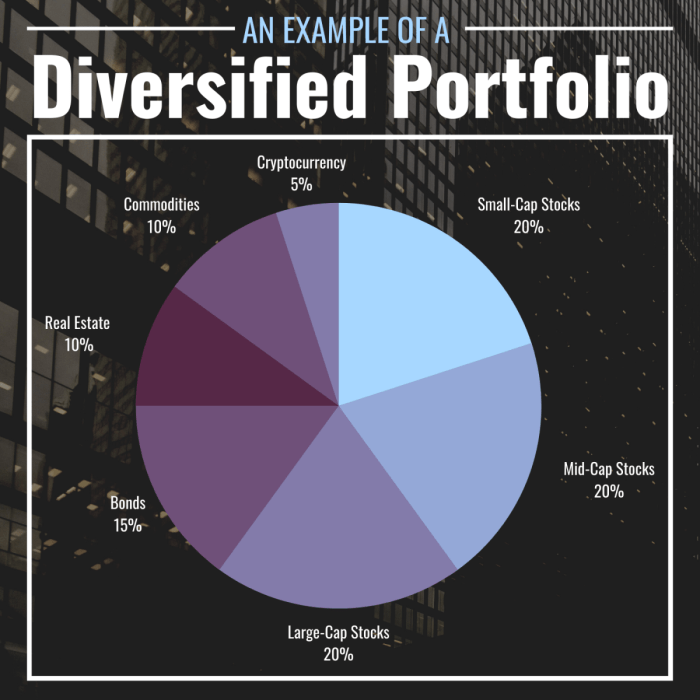Investment diversification is like creating a financial mixtape, blending different assets to reduce risk and boost long-term gains. Let’s dive into the art of spreading your investment eggs across multiple baskets.
Importance of Investment Diversification
Investment diversification is crucial for managing risk in your portfolio. By spreading your investments across different asset classes, industries, and geographic regions, you can reduce the impact of market volatility on your overall returns.
Protecting Against Market Volatility, Investment diversification
Diversification can shield your portfolio from the ups and downs of individual investments. For example, if you only invest in one sector like tech stocks and that sector experiences a downturn, your entire portfolio could suffer. However, by diversifying into other sectors like healthcare, real estate, or consumer goods, you can offset potential losses in one area with gains in another.
Achieving Long-Term Financial Goals
One of the key benefits of diversification is its role in helping you achieve your long-term financial goals. By spreading your investments across a variety of assets, you can potentially increase your chances of earning consistent returns over time. This can be especially important when saving for retirement or other major life milestones, as it helps protect your nest egg from significant market fluctuations.
Strategies for Investment Diversification
Diversification is essential in creating a balanced investment portfolio to minimize risk and maximize returns. Here are some strategies to consider:
Asset Classes for Diversification
- Stocks: Investing in different companies across various industries can help spread risk.
- Bonds: Adding bonds to your portfolio can provide stability and income.
- Real Estate: Investing in properties or real estate investment trusts (REITs) can diversify your portfolio.
- Commodities: Including commodities like gold, silver, or oil can hedge against inflation.
Allocation Tips
- Allocate investments across different sectors such as technology, healthcare, finance, and consumer goods.
- Consider the size of companies you invest in, including large-cap, mid-cap, and small-cap stocks.
- Balance risk by investing in both domestic and international markets.
Understanding Correlation
Correlation measures the relationship between different assets in a portfolio. A correlation of +1 means two assets move in perfect harmony, while -1 indicates they move in opposite directions. By including assets with low or negative correlation, you can reduce overall portfolio risk.
Risks Associated with Lack of Diversification

Having a concentrated investment portfolio can expose investors to a variety of risks that can significantly impact their financial well-being.
Amplification of Losses during Market Downturns
When your investments are concentrated in a single asset class or industry, any negative movements in that specific sector can result in substantial losses for your portfolio.
- For example, during the dot-com bubble burst in the early 2000s, many investors who had heavily invested in technology stocks suffered massive losses when the tech sector crashed.
- Similarly, in the 2008 financial crisis, those with concentrated holdings in real estate or banking sectors experienced severe setbacks when these industries faced turmoil.
Historical Events with Significant Financial Setbacks
There have been several instances in history where lack of diversification led to catastrophic financial consequences for investors.
- One such example is the collapse of Enron in 2001, where employees who had most of their retirement savings invested in company stock lost everything when the scandal broke out.
- Another notable event is the fall of Lehman Brothers in 2008, which caused massive losses for investors who had concentrated their holdings in the banking sector.
Monitoring and Rebalancing a Diversified Portfolio: Investment Diversification
Regularly monitoring a diversified portfolio is crucial to ensure that your investments are aligned with your financial goals and risk tolerance.
Importance of Regular Monitoring
Monitoring allows you to track the performance of each asset class within your portfolio and make informed decisions based on market trends and changes in your investment objectives.
Concept of Rebalancing
Rebalancing involves adjusting the allocation of assets in your portfolio to maintain the desired level of diversification. This ensures that your risk exposure is in line with your risk tolerance and investment goals.
Best Practices for Adjusting Investments
- Regularly review your portfolio to assess whether the asset allocation is still in line with your investment strategy.
- Consider reallocating funds from overperforming assets to underperforming ones to maintain balance.
- Rebalance your portfolio at least once a year or whenever there are significant changes in market conditions.
- Consult with a financial advisor to get professional guidance on rebalancing strategies based on your individual financial situation.
